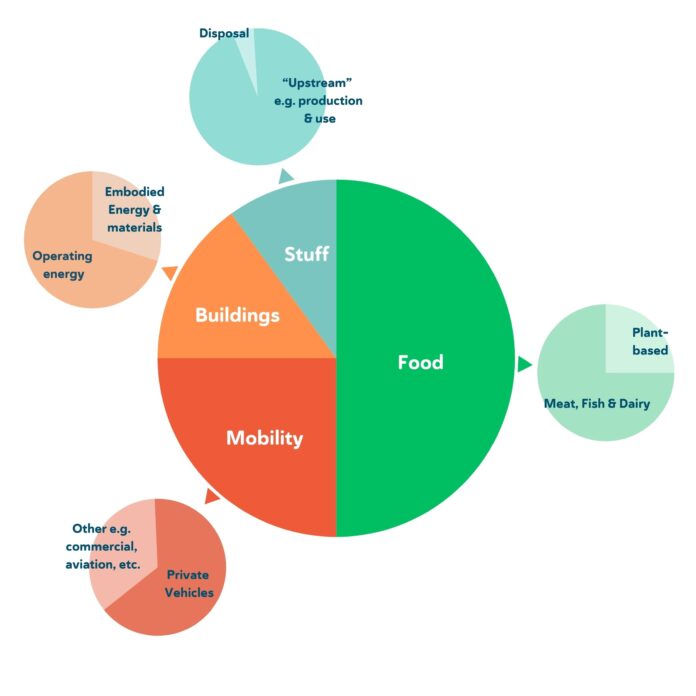SUBMITTED BY TRANSITION SALT SPRING
Part of the Lighter Living series
How many of us cringe at the thought of cleaning out the crisper drawer in the fridge? Perhaps there might be a mouldy cucumber, slimy spinach, shrivelled carrots, or maybe leftovers from last week that you promised yourself to use up.
Recent research shows that a whopping 50 per cent of our ecological footprint in southwest B.C. is tied to food (mobility 25 per cent, buildings 15 per cent, and stuff 10 per cent). This 50 per cent figure includes all the energy and resources that go into growing, producing, packaging, transporting, distributing and disposing of food. The choices we make every day related to what we eat or don’t eat have a significant impact on our “foodprint.”
According to recent research (UN Environment, One Earth, 2021), the most effective action individuals can take to reduce their carbon footprint as it relates to food is to reduce the amount of wasted food at home. Approximately 40 per cent of our landfill is made up of food waste, with each household in the Capital Regional District throwing away around $1,500 worth per year. The most commonly discarded foods, in descending order, include vegetables, fruit, snacks and staples, leftovers, bakery items, dairy and meat.
The Canadian Zero Waste Council reported that 63 per cent of the food we throw away could have been eaten. Some food waste is unavoidable, such as parts that generally can’t be sold or eaten, like bones, vegetable peelings, egg shells or coffee grounds. Avoidable food waste refers to edible food that ends up in the compost or garbage because we bought too much, cooked too much, didn’t like it or didn’t store it properly.
There are plenty of reasons for all this food waste at home, including food getting “lost” inside people’s fridges, consumers misinterpreting food date labels, impulse buying, poor planning before shopping and a general lack of awareness about the need to reduce food loss. Eating the food we purchase or grow should be a top priority when it comes to preventing waste. Fortunately, there are plenty of great ideas, tips and tricks to address the underlying drivers of all this waste. None of these steps are particularly difficult or cumbersome.
SaveFood Canada suggests three simple steps and provides plenty of details regarding their “Plan it Out, Use it Up and Keep it Fresh” method, including an encyclopedia of food storage best practices. Several behavioural scientists suggest organizing our fridges completely differently, recommending a Feng Shui approach. “Best by” and “use-by” dates are not the same thing, and neither necessarily means that a product is no longer good.
Unfortunately, when we throw away edible food, we not only lose the energy, time and resources that went into getting the food from seed to table but also contribute to methane gas production in landfills. Methane is 28 times more powerful than carbon dioxide at trapping heat in the environment when food decomposes.
Many islanders are keen composters, each with a method that works for them. For example, Alicia Herbert invites two of her neighbours to contribute their food scraps to her large plastic bins, sharing surplus bounty from her garden in return. Patti Wardlaw loves her Speedibin composter, designed and built in B.C. from galvanized metal, which allows composting all food waste, including meat scraps, without pest problems. Deborah Miller swears by trench composting, dumping all food waste into pre-dug 30-centimetre-deep trenches in fallow beds. Barbara Dempster uses a digester for non-plant-based scraps, Nancy Deas feeds scraps to the family flock of hens and Andria Scanlan divides food scraps between a standard plastic composter and worm bins.
The good news is that small choices can make a big impact, especially when we work together. A number of excellent resources are available for free to islanders who love food but hate waste. The Salt Spring Island Farmland Trust (SSIFT) offers a Harvest Share program for those with fruit trees they are unable to harvest, sending trained volunteers to do the work and sharing the harvest equally among landowners, volunteers and partner organizations supporting food-insecure individuals. also hosts a Food Exchange program every Sunday afternoon, encouraging surplus food from gardens in exchange for produce one does not grow; leftovers are donated to partner organizations like food banks. They also offer workshops, including ones on composting and vermiculture. For more information on all their offerings, visit ssifarmlandtrust.org.
To learn more about how to waste less food, Transition Salt Spring invites you to sign up for free access to Lighter Living Salt Spring content at tinyurl.com/Lighter-Living. Learn how to take low-effort actions that make you feel good, benefit our community, and help the planet.

